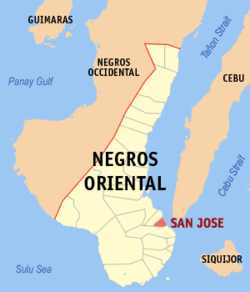San Jose, Negros Oriental
| San Jose | |
|---|---|
| Municipality | |
 Map of Negros Oriental with San Jose highlighted | |
.svg.png) San Jose Location within the Philippines | |
| Coordinates: 09°25′N 123°14′E / 9.417°N 123.233°ECoordinates: 09°25′N 123°14′E / 9.417°N 123.233°E | |
| Country | Philippines |
| Region | Negros Island Region (NIR/Region XVIII) |
| Province | Negros Oriental |
| Congr. district | 2nd district of Negros Oriental |
| Established | 1954 |
| Barangays | 14 |
| Government[1] | |
| • Mayor | Nelson Ruiz |
| • Vice Mayor | Mel Nick Logronio |
| Area[2] | |
| • Total | 54.46 km2 (21.03 sq mi) |
| Population (2010)[3] | |
| • Total | 19,098 |
| • Density | 350/km2 (910/sq mi) |
| Time zone | PST (UTC+8) |
| ZIP code | 6202 |
| Dialing code | 35 |
San Jose is a fifth class municipality in the province of Negros Oriental, Philippines. According to the 2015 census, it has a population of 20,413 people.[4] San Jose is the Regional Pineapple Capital.
Barangays
San Jose is politically subdivided into 14 barangays, shown here with population as of 2015 Census:
- Basak - 827
- Basiao - 673
- Cambaloctot - 652
- Cancawas - 1,746
- Janayjanay - 938
- Jilocon - 1,944
- Naiba - 790
- Poblacion - 939
- San Roque - 942
- Santo Niño - 2,132
- Señora Ascion (Calo) - 1,913
- Siapo - 2,182
- Tampi - 2,058
- Tapon Norte - 2,677
History
The municipality of San Jose was formerly called "Ayuquitan", a name that was born due to a communication problem between the natives and Spanish Conquistadors. The story was that one day a group of Spaniards searching for flourishing communities came upon a group of natives harvesting rice. The Spaniards approached the natives and asked the name of the place while pointing to the ground filled with piles of rice chaffs. The natives thought they were asked for the name of the pile and answered "Inoquitan". From then on, the Spaniards called the place "Inoquitan". In time, the name "Ayuquitan" was adapted from the phrase "may inoquitan". In 1902 Governor Demetrio Larena considered the place as a pueblo. San Jose is the home of the old Spanish families settled since 1871 like the Patero, Amiscaray, Larena, Pareja, Siglos, Remollo, Renacia, Remata, Araco and Remoto.
San Jose was created as a town in 1954 from the barrios of Ayuquitan, Basak, Basiao, Cambaloctot, Calo, Cancawas, Hanay-Hanay, Jilocon, Lalaan, Naiba, Tapon Norte, Tampi, and sitios Guinsayawan, Kang-atid, Kangdajonog, Guilongsoran and Kaputihanan of the barrio of Siapo, all of which formerly belonged to the former municipality of Ayuquitan and then part of the municipality of Amlan.[5]
Demographics
| Population census of San Jose | ||
|---|---|---|
| Year | Pop. | ±% p.a. |
| 1990 | 12,821 | — |
| 1995 | 14,952 | +2.92% |
| 2000 | 15,665 | +1.00% |
| 2007 | 17,250 | +1.34% |
| 2010 | 19,098 | +3.77% |
| 2015 | 20,413 | +1.28% |
| Source: National Statistics Office[3] | ||
Attractions
The town is the gateway to the Balinsasayao Twin Lakes Natural Park in Enrique Villanueva, Sibulan Town.
One of the tourist attraction of the town was the Our Lady of Lourdes Shrine in the cane fields of Cambaloctot, where a spinning sun is said to have manifested the visit of the Lady of Lourdes, devotees flock every Saturday of the month.
The Ayuquitan Festival is held every May 7, one of the highlights of the town fiesta which is celebrated on May 10. Street dancing and showdown are the main features of the festival.
The St. Paul University Farm in Barangay Sra. Acion
References
- ↑ "Elected Mayors – Vice-Mayors and Councilors in Negros Oriental". Dumaguete.com. Retrieved 2016-05-16.
- ↑ "Province: Negros Oriental". PSGC Interactive. Makati City, Philippines: National Statistical Coordination Board. Retrieved 13 March 2013.
- 1 2 "Total Population by Province, City, Municipality and Barangay: as of May 1, 2010" (PDF). 2010 Census of Population and Housing. National Statistics Office. Retrieved 13 March 2013.
- ↑ "NEGROS ISLAND REGION (NIR)". Census of Population (2015): Total Population by Province, City, Municipality and Barangay (Report). PSA. Retrieved 20 June 2016.
- ↑ "An Act Creating the Municipality of San Jose, Province of Negros Oriental". LawPH.com. Retrieved 2011-04-11.
External links
- Philippine Standard Geographic Code
- Philippine Census Information
- Local Governance Performance Management System
 |
Amlan |  | ||
| Amlan | |
Tañon Strait / Santander, Cebu | ||
| ||||
| | ||||
| Sibulan |